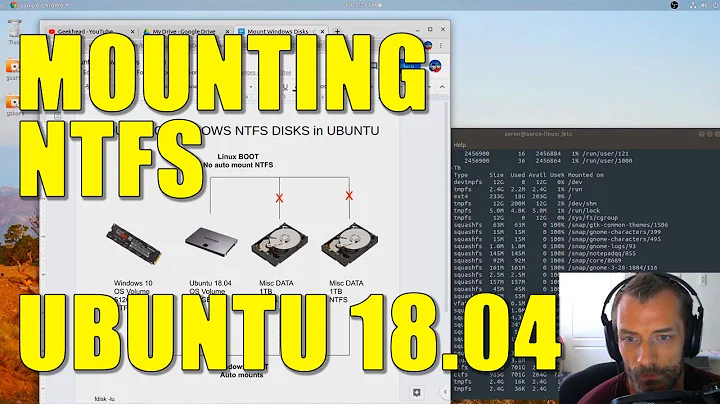Install Ubuntu on a NTFS partition
Solution 1
No. NTFS doesn't support Linux file permissions so you can't install a Linux system on it.
Solution 2
It is possible to install Ubuntu on a NTFS partition.
Image Creation
You need to create an image file on your NTFS partition. Try boot up your Ubuntu Live CD, start a terminal, change directory into your NTFS partition, and create a image file:
cd /media/ubuntu/<your_ntfs_partition>/
mkdir linux
cd linux/
dd if=/dev/zero of=./linux.img bs=1M count=32768
mkfs.ext4 ./linux.img
This will create an image file of size 32GB with EXT4 at linux/linux.img
Loopback Filesystem Setup
Now, create a virtual block device at /dev/sdX where X is a non-occupied block device character (i.e. I only have /dev/sda, so I used /dev/sdb);
Also choose a minor number (in this case 200) that is not in use with ls -al /dev:
sudo mknod /dev/sdb b 7 200
sudo losetup /dev/sdb ./linux.img
Installing Ubuntu
You can now launch the Ubuntu installer and install Ubuntu on /dev/sdX, make sure you have install the bootloader to your real disk (or EFI partition) if you don't have Windows installed on that disk. After the installation, you need to get the kernel and initrd file name by mounting the image:
sudo mkdir /media/ubuntu/rfs
sudo mount -o loop /dev/sdb /media/ubuntu/rfs
ls -al /media/ubuntu/rfs/boot
Mark down the kernel and initrd filename, in my case that's vmlinuz-4.4.0-31-generic, and initrd.img-4.4.0-31-generic.
Bootloader
I have a Windows on my NTFS partition, so I have chosen Grub2Win as my bootloader. However, if you don't have Windows installed and insisted to use a NTFS partition (which is no point to do so though), GRUB should have installed on your disk in the previous step. No matter you use Grub2Win or the original GRUB, You need to edit your GRUB config and use the following:
echo Booting linux...
loopback loop0 (hd0,1)/linux/linux.img
set root=(loop0)
linux /boot/vmlinuz-4.4.0-31-generic root=/dev/sda1 loop=/linux/linux.img rw verbose nosplash
initrd /boot/initrd.img-4.4.0-31-generic
You need to edit (hd0,1) and /dev/sda1 to the NTFS partition that your linux image resides in. You may use the GRUB command line to get it. Also modify the kernel and initrd filenames according to your installation. Make sure your GRUB have NTFS and loopback support.
Now, when you boot the disk, you can boot into Ubuntu with GRUB. I have written my steps and procedure to here, but I am using Grub2Win as I mentioned earlier.
Solution 3
I'm not sure what your "certain circumstances" are, but you are better off resizing the partition and letting Ubuntu have its own space. You can always resize/move the Ubuntu partition later.
You cannot install Linux on an NTFS system for security, technical, and other reasons (for example, NTFS is supported by a user-space driver).
Solution 4
Supposedly, wubi is an Ubuntu installer which allows to "install and uninstall Ubuntu in the same way as any other Windows application" - I never tried this but I suppose the whole partition is contained in a file which can be on an NTFS drive.
http://www.ubuntu.com/download/ubuntu/windows-installer
I'm pretty sure it's not possible to install Ubuntu on an NTFS partition in the traditional sense of the word - i.e. as a stand-alone OS which directly accesses the drive etc. For one thing, filesystem permissions models are quite different etc.
However, you can access NTFS partitions from an Ubuntu which is installed on a, for example, ext4-partition.
Related videos on Youtube
Oxwivi
Updated on September 18, 2022Comments
-
Oxwivi almost 2 years
The Ubuntu installer does not allow me to install on NTFS partitions, but certain circumstances requires me to do so. Is it possible?
-
Binarylife almost 13 yearsWubi? ... and If the installer allows you to install on NTFS partitions , the filesystem should be changed to ext4 ? am I right?
-
Oxwivi almost 13 yearsI won't be running Windows.
-
Binarylife almost 13 yearsI see, I don't think there is a way to do it.
-
 Admin almost 13 yearsWhich circumstances require NTFS? You can install Ubuntu on ext* and use another partition (NTFS) for those circumstances...
Admin almost 13 yearsWhich circumstances require NTFS? You can install Ubuntu on ext* and use another partition (NTFS) for those circumstances... -
Oxwivi almost 13 yearsIt's on a USB, and live USB certainly is not the desired solution. I have failed to use
fstaband bind NTFS folders to the ones in my Ubuntu install. -
enzotib almost 13 yearsWhy do not format USB partition with extN?
-
Oxwivi almost 13 years@enzotib, that'd be fine, but I need it accessible to Windows systems. The USB is dual purpose to serve as storage medium and a portable operating system as well.
-
enzotib almost 13 yearsSo make a first primary partition for windows storage, and another partition for installing ubuntu (plus swap, if needed)
-
Oxwivi almost 13 yearsYes, well, as you can read my comment in reply to Rachid, I failed. I wanted to bind a few folders to make them available both to my storage and Ubuntu folders, but for some reason it did not work out.
-
13east almost 13 yearsformat and install to the partition as fat32... should be accessible in linux and windows
-
Oxwivi almost 13 years@13east, 4 GB file size limit is not a limitation I can entertain.
-
13east almost 13 yearsthan you should partition the usb-drive into two drives as mentioned earlier... NTFS is not a linux supported system and read/write access to it were only achieved after working out backwards compatibility issues (ntfs-3g)... have your storage drive as the first partition and USB-live installation as second because windows will only give you access to the first accessible drive on a USB drive
-
Kong Chun Ho about 7 yearsIf you are still wondering about this, please see this.
-
-
Oxwivi almost 13 yearsBut there's no Windows for me to install Wubi in...
-
Oxwivi almost 13 yearsNo ugly hacks either?
-
LGB almost 13 yearsIf you don't have windows, why do you need NTFS? Just forget it. It's like you want to install Windows on ext2/3/4, even if you don't have any Linux to support ext* filesystems :) But anyway, in theory, it's not totally impossible to install on NTFS: you can create a big enough file on the NTFS, which is used as a loopback mount (so that file will be the ext3/4 "inside"). However, I am not sure if there is simple method to do this ... Even in that case, from Linux's view point, it's installed on ext2/3, just it's only a file on NTFS then ...
-
Oxwivi almost 13 yearsSounds promising, any hints as to where I can find more info about such stuff?
-
Michael Gundlach almost 13 yearsWubi only works because it creates a disk blob partitioned as a drive with EXT3 installed inside of that disk blob. Ergo blob exists on NTFS partition. But it's more of a disk inside of a disk then Ubuntu on NTFS
-
Thomas Ward almost 13 yearsIt does not work in that manner. You won't be able to install Ubuntu onto an NTFS partition - the permissions systems just do not work on that type of partition.
-
Oxwivi almost 13 years@Marco, can we bind folders from a live USB's disk blob to some folder in the NTFS partition?
-
Michael Gundlach almost 13 years@Oxwivi Over my head at that point.
-
Christopher B. Adkins almost 13 years@Oxwivi POSIX Overlay Filesystem seems to do this.
-
Christopher B. Adkins almost 13 yearsI never used it, just found it while searching the web. The tarball contains some short docs
-
Sounix Souleke over 12 yearsAlso, symbolic links are not supported by NTFS and are required.
-
Jason Southwell over 12 years@NRoach44: you can add your own answer if you like :)...
-
William over 8 yearsI am not really satisfied by this answer. Isn't there a way to ignore system permissions? There is Cygwin, VirtualBox and Samba surely there is somewhat to get it to partially working. Although they certainly don't imply such would work.
-
 Suici Doga over 8 yearsWubi doesn't work with Windows 8/10
Suici Doga over 8 yearsWubi doesn't work with Windows 8/10 -
 Zanna about 7 yearsplease don't write an answer just to refer to another question. That can be done using comments when you have enough reputation, or by flagging as a duplicate if appropriate
Zanna about 7 yearsplease don't write an answer just to refer to another question. That can be done using comments when you have enough reputation, or by flagging as a duplicate if appropriate -
Kong Chun Ho about 7 yearsSorry, I am gonna write up a full answer. This question does not duplicate with the another question, the answer of this question does, however, requires actions involved in the answer of that question.
-
 Zanna about 7 yearsOk, please edit your answer :)
Zanna about 7 yearsOk, please edit your answer :) -
Kong Chun Ho about 7 yearsDone. Could the downvoter kindly retract your downvote? Thanks.
-
 Zanna about 7 yearsIt wasn't me... and whoever it was won't be notified. I don't understand the topic well enough to upvote your answer, hopefully others will
Zanna about 7 yearsIt wasn't me... and whoever it was won't be notified. I don't understand the topic well enough to upvote your answer, hopefully others will -
Kong Chun Ho about 7 yearsSure, no problem. :)
-
antont about 7 yearsHowever you don't actually use NTFS but ext4: "It basically creates a RAW image file on the NTFS partition, and formatted it as EXT4." - so you are not installing ubuntu on NTFS so that it would stay NTFS when used etc. , which I think was the intent of the question. Seems that running Linux on NTFS is not supported (except by a kind of virtualization like wubi)
-
Kong Chun Ho about 7 years@antont Well, that depends on how you see it. The RAW image file is organized with EXT4, but this image file is reside on a NTFS partition. It uses NTFS though as the setup will not work if your kernel doesn't support NTFS.
-
 phuclv over 6 yearsit's actually incorrect. it's possible to store Linux permissions with ntfs-3g. In the past it was also possible to install Linux on FAT
phuclv over 6 yearsit's actually incorrect. it's possible to store Linux permissions with ntfs-3g. In the past it was also possible to install Linux on FAT -
whoKnows about 6 yearsWhat should /etc/fstab look like in this scenario?
-
Kong Chun Ho about 6 years@whoKnows Sorry for late reply. In this case, the
/etc/fstablooks like this:UUID=8616f9db-70ac-496e-a6b2-808a36332dc4 / ext4 errors=remount -ro 0 1. It looks like it is using a UUID instead of a block device. -
user541686 over 5 yearsNow that WSL provides a standard way to store permissions on NTFS... any updates?
-
Jason Southwell over 5 years@Mehrdad that's clearly NOT recommended, and potentially dangerous. I'm deleting your comment to protect new users. Also, when replying with such comments, make sure to check the date of the answer.
-
user541686 over 5 years@RolandiXor: I did read it, but I'm saying the reasoning is incorrect, and that has nothing to do with the date. Clearly the fact that NTFS is supported by a userspace driver doesn't prevent it from being used. The fact is your reasons are bogus and don't prevent this from happening. It's a an abuse of mod privileges in my book to delete my comment when I'm pointing out your answer is incorrect, but in any case, you should update your answer first so that it doesn't lie to people...




